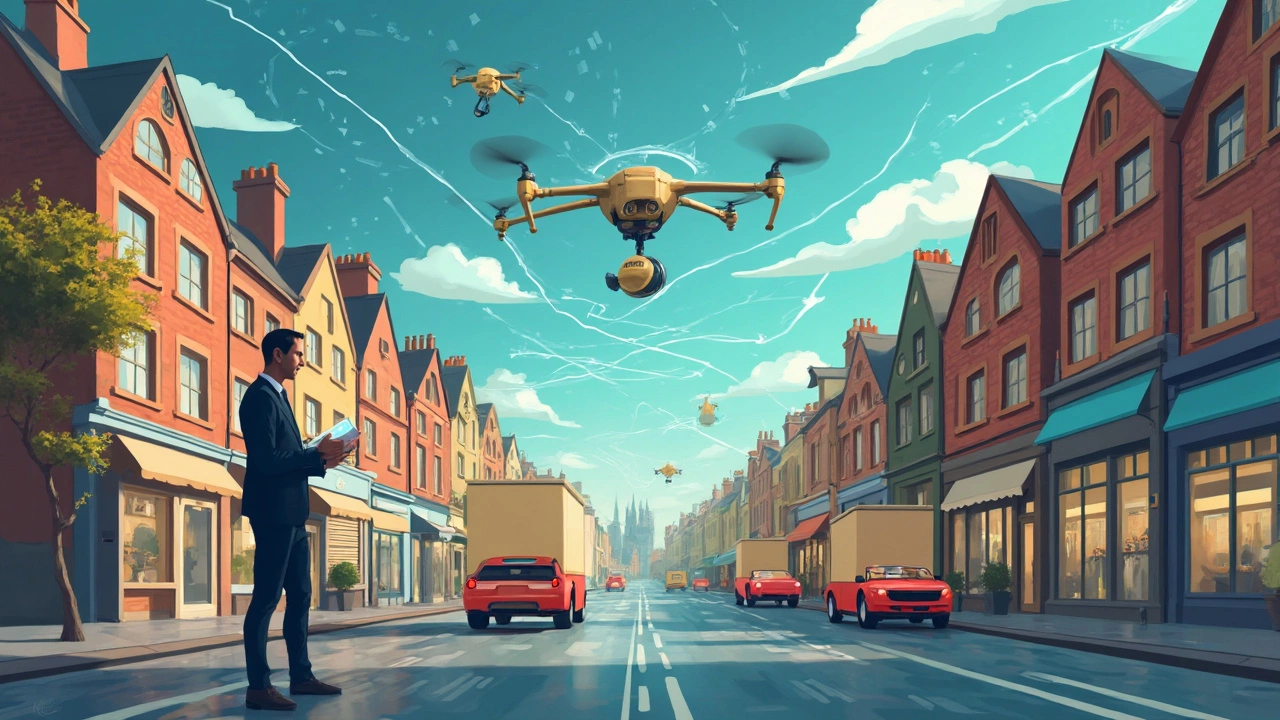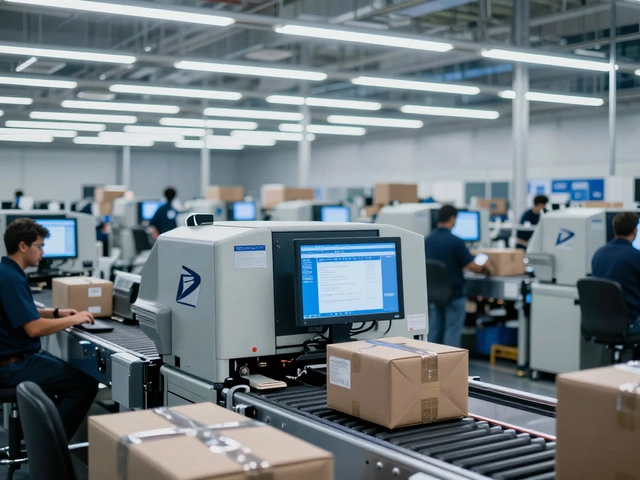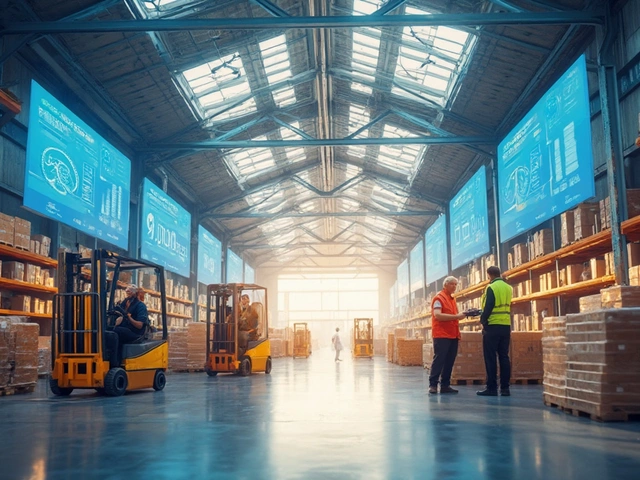Ever wonder how your online orders magically appear at your doorstep so quickly? It's not magic, it's e-logistics. E-logistics plays a crucial role in e-commerce, serving as the backbone that ensures everything from checkout to delivery runs smoothly. At its core, e-logistics involves managing the supply chain with the help of technology. This means keeping track of inventory, processing orders, and making sure those cute shoes you ordered actually get to you on time.
It's fascinating how much goes into it. Imagine a busy warehouse, bustling with activity, where robots might be zipping around, transporting items from shelves to packing stations. Human workers oversee the operations, ensuring that everything flows like clockwork. In many cases, the system is so efficient that orders can be processed and shipped within hours.
- Understanding E-Logistics Basics
- Role of Technology in E-Logistics
- Inventory Management Strategies
- Delivery and Fulfillment Challenges
- Tips for Optimizing E-Logistics
Understanding E-Logistics Basics
Alright, let's break down e-logistics and figure out how it supports the madness of online shopping. Essentially, e-logistics is the engine driving e-commerce, making sure that everything in the supply chain clicks together just right.
The Core Components
First up, inventory management. With e-logistics, businesses can keep tabs on stock levels in real-time. This means you often see the benefits as a customer when you get a notice that something you want is back in stock right after it sells out. Companies use software that integrates with their online stores to update this info regularly, so they're never left guessing.
Then there's order processing. Imagine this as a series of perfectly choreographed moves: once you click 'buy,' your order gets logged into a system, payment is confirmed, and the wheels start turning. An efficient e-logistics setup ensures that there's no downtime when handling these steps, reducing errors and speeding up the whole process.
Deliveries Demystified
Remember those delivery drones everyone was talking about? Well, while we're still waiting for our Amazon packages to be dropped from the sky, e-logistics involves a lot of other cool tech, like automated route planning. This tech not only picks the quickest delivery path but also considers things like traffic patterns to avoid any hiccups.
- Real-time tracking: Customers love this feature. It uses GPS to show exactly where your package is at any moment.
- Efficient warehousing: Neutralizes the 'where did I put that?' problem by placing items in spots where they're needed most.
- Communication: Ensures drivers, warehouse staff, and customer service teams are all on the same page.
By optimizing these different parts, businesses can cut costs, improve speed, and make sure customers remain happy enough to come back for more.
Role of Technology in E-Logistics
Technology is the secret sauce in e-logistics, making the whole system tick effortlessly. It's not just about having a website to sell stuff. It's about using cutting-edge tech to streamline every step from when you click 'buy' to when your package lands at your door.
Tracking and Inventory Management
One major player in this is inventory management software. Imagine being able to see exactly how many blue shirts are in stock, across multiple warehouses, all in real-time. This software doesn't just track stock; it predicts demand, so you're never left empty-handed without a best-seller on your shelves.
Automated Warehousing
Remember those robots we mentioned earlier? They're powered by smart tech that makes warehouses super efficient. Automated Guided Vehicles (AGVs) move products from one place to another with precision, reducing the time human workers spend walking from aisle to aisle. This tech helps in saving money and getting packages out the door faster.
Advanced Delivery Systems
E-logistics leverages the latest in GPS tracking and mapping technology to optimize delivery routes. This means fewer missed deliveries and faster shipping times. Have you heard about drone deliveries? They’re not just a future concept. Some companies are already using drones to drop off packages, cutting delivery times down dramatically, especially in urban areas.
By integrating these technologies, businesses are hitting new highs in customer satisfaction levels. It's no wonder that those embracing e-logistics are pulling ahead in the competitive world of e-commerce.

Inventory Management Strategies
When it comes to e-logistics, mastering inventory management is like finding the holy grail. You want to keep just the right amount of inventory on hand—not too little that you miss out on sales, and not too much that you're drowning in unsold products.
Real-Time Inventory Tracking
One of the best strategies is using real-time inventory tracking software. This technology keeps tabs on your stock levels 24/7, so you know exactly what's in your warehouse. Many businesses implement barcoding and RFID tags that allow for instant updates as items are moved, and this can save a lot of headaches during peak sales periods, like Black Friday.
Demand Forecasting
Understanding customer behavior can also be a game-changer. Demand forecasting uses historical sales data, market trends, and even social media signals to predict future sales patterns. Some retailers have even reported a 10-15% improvement in stock efficiency through advanced forecasting algorithms.
Just-In-Time (JIT) Inventory
If you're looking to optimize, consider Just-In-Time (JIT) inventory. This strategy means receiving goods only when they're needed for production or sales, reducing storage costs. However, it's essential to have a reliable and speedy supplier, as any delays can cause a ripple effect.
Automated Reordering Systems
Don't underestimate the power of technology. Automated reordering systems can help you maintain optimal stock levels. When inventory dips below a set threshold, the system can automatically place an order with your supplier. This prevents those pesky out-of-stock situations that leave customers frustrated.
For added context, many businesses have reported reducing their inventory costs by 20% simply by implementing these strategies. That's cash that can be better spent elsewhere in your business.
Delivery and Fulfillment Challenges
When it comes to e-commerce logistics, delivery and fulfillment often present some of the toughest challenges. It all starts when an order is placed, and the clock starts ticking. Customers expect their items fast, sometimes even on the same day. So, what's standing in the way?
Last-Mile Delivery
A big hurdle is the infamous 'last-mile' delivery. This is the final stretch where items go from the fulfillment center to the customer's doorstep. It's tricky because it involves navigating urban traffic, unpredictable weather, and finding addresses tucked away in hard-to-reach places. For businesses, this step can be the most expensive, accounting for over 50% of total shipping costs.
Inventory Management
Making sure the right items are in stock can be a headache. Countless times, you see "out of stock" messages just as you're about to make a purchase. To prevent this, companies need to predict demand accurately and adjust stock levels accordingly. But forecasting isn't foolproof and surprises happen.
Handling Returns
Returns are inevitable in e-commerce, challenging logistics teams to handle reverse logistics efficiently. An efficient return process helps maintain customer satisfaction and trust. Yet, managing returns can be costly and complicated, especially if items need repair or remanufacturing.
Technology Integration
Technology is supposed to help, right? But for some businesses, integrating new tech with existing systems can be daunting. Many still rely on outdated software or manual processes that slow down operations. Embracing new solutions like AI and automation is essential but isn't as easy as flipping a switch.
| Challenge | Impact |
|---|---|
| Last-Mile Delivery | High costs, logistical complexity |
| Inventory Management | Stockouts, overstocking issues |
| Returns Handling | Increased costs, satisfaction impacts |
| Technology Integration | Operational delays, efficiency drops |
So, what's the way forward? Businesses are looking at centralized warehouses, partnerships with local delivery services, and even drones to cut down on delivery times. Companies that smooth out these wrinkles in their e-logistics processes will not only save costs but will delight their customers too.

Tips for Optimizing E-Logistics
Getting the best out of your e-logistics setup doesn't mean you need to overhaul your entire system, but a few tweaks here and there can significantly speed up and smooth out your operations. Here are some practical tips to get you started.
Embrace Automation
Automation is a game-changer in the supply chain process. Introducing automated processes can cut down on manual tasks, reduce errors, and make everything faster. Think about using software to automatically update inventory or even robots for picking and packing. An automated system can work 24/7 without breaks, giving you an edge in fulfilling orders quickly.
Real-time Inventory Tracking
Keeping tabs on your stock levels in real-time is essential. You don’t want customers ordering items that are out of stock. With tools that automatically update your inventory counts, your system will be always up-to-date, which means you'll know exactly what you have and where it is. This isn’t just about accuracy, but it also helps in forecasting and planning.
Optimize Delivery Routes
This might sound like a small tweak, but optimizing delivery routes can save a ton of time and fuel. Use algorithms or route planning software to find the shortest, most efficient paths for deliveries. This reduces shipping times and costs, making your delivery process more effective.
Integrate Data Analytics
Data is power. Analyzing trends and patterns in your logistics can reveal insights you might miss. Maybe there's a delay pattern with a particular shipping partner, or maybe one product always hits a snag in the warehouse. Use data to constantly refine and improve your operations.
Build Strong Partnerships
Finally, don't underestimate the value of a strong relationship with your suppliers and shippers. Good communication can resolve issues quickly and keep everybody on the same page. Sometimes, a quick phone call can save you from major logistics headaches.
Implementing these tips can streamline your e-commerce logistics, boosting efficiency and keeping your customers happy. With the right setup, even small improvements can lead to big changes in performance.





